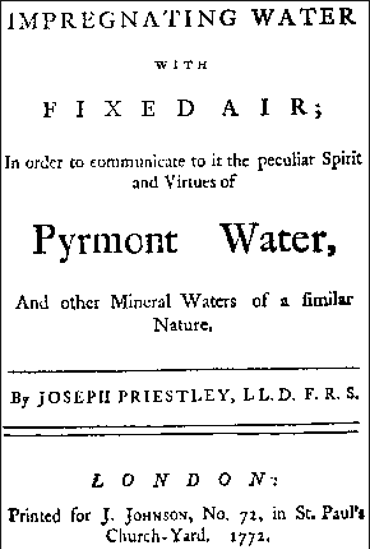The fizz cocktail family is the literal extension of the sour. A sour, when lengthened with carbonated water, is a fizz. This simple addition has big effects, and is responsible for the plethora of cocktails that are topped with soda. Think of a fizz as a lengthened and more refreshing take on a sour. The soda's effervescence contributes a cooling effect and helps lift the aromatics upward. Appropriately, you'll see many fizzes in the summer.
A Fizz Cocktail
 Soda meets Booze
Soda meets Booze
Fizzes were made possible by a technological marvel known as carbonated water. In 1772, Joseph Priestly pioneered methods of carbonation, and prophetically mentioned its effects on alcohol:
"By this process may fixed air be given to wine, beer, and almost any liquor whatever: and when beer is become flat or dead, it will be revived by this means..."
The fanfare over carbonated water did indeed spill over into the cocktail glass, and the addition of soda to cocktails became hugely popular in the 19th century - the fizz was here to stay.
Hold The Ice
Like the sour, a fizz is shaken with ice, strained and served up.
Crucially, this means that a cocktail with ice and soda is not technically a fizz. When most people think of drinks topped with soda, they often think of drinks served on the rocks, which are a sister family known as collins/highballs.
The classic fizz is the gin fizz. It provides the perfect starting point for the whole fizz family.
Gin Fizz
Shake all except the soda with ice and strain into a highball glass. Top with soda.
Since a fizz lacks ice and it classically quite a small drink, it warms quickly and is meant to be downed briskly (as if you needed any more motivation!).
Getting Fizzy With It
As with any pioneering cocktail, the gin fizz was a springboard for variations. The addition of an egg white to the gin fizz creates a Silver Gin Fizz, for example. A whole egg? That's a Royal Fizz. If you just can't bear to drink your champagne by itself, swap it in for the club soda and you'll get the illustrious Diamond Fizz, better known by its more sexy name, the French 75.
The list of fizzes goes on and on, so once you know the basic recipe, mixing and matching becomes child play. Remember, any sour cocktail that you enjoy can be easily converted into a fizz.

 Soda meets Booze
Soda meets Booze